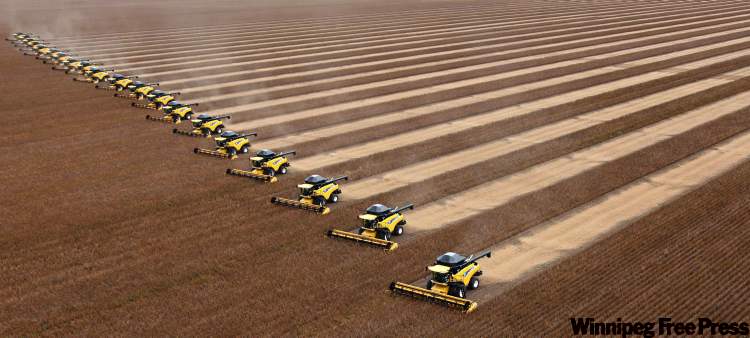Restoring balance to food supply
Advertisement
Read this article for free:
or
Already have an account? Log in here »
To continue reading, please subscribe:
Monthly Digital Subscription
$1 per week for 24 weeks*
- Enjoy unlimited reading on winnipegfreepress.com
- Read the E-Edition, our digital replica newspaper
- Access News Break, our award-winning app
- Play interactive puzzles
*Billed as $4.00 plus GST every four weeks. After 24 weeks, price increases to the regular rate of $19.00 plus GST every four weeks. Offer available to new and qualified returning subscribers only. Cancel any time.
Monthly Digital Subscription
$4.75/week*
- Enjoy unlimited reading on winnipegfreepress.com
- Read the E-Edition, our digital replica newspaper
- Access News Break, our award-winning app
- Play interactive puzzles
*Billed as $19 plus GST every four weeks. Cancel any time.
To continue reading, please subscribe:
Add Winnipeg Free Press access to your Brandon Sun subscription for only
$1 for the first 4 weeks*
*$1 will be added to your next bill. After your 4 weeks access is complete your rate will increase by $0.00 a X percent off the regular rate.
Read unlimited articles for free today:
or
Already have an account? Log in here »
Hey there, time traveller!
This article was published 26/07/2011 (5161 days ago), so information in it may no longer be current.
Famine is the most extreme consequence when demand and supply of food are out of balance, but there are other severe consequences. In this the last of a three-part series, Stuart Clark, a biological engineer and senior policy adviser to the Winnipeg-based Canadian Foodgrains Bank, explains how the food supply has become an international concern and how that concern might be addressed. The entire series is available at
winnipegfreepress.com

The water bucket that is our global food supply is nearly empty. Water leaks out through holes labelled food, animal feed and biofuels. Farmers used to be able to keep it full — sometimes to overflowing. But these days it is beginning to head towards empty. What can be done to restore the balance so the bucket fills to a safe level?
One way is through increased agricultural production — new farm machinery, new seeds, new types of fertilizers and more irrigation. That would certainly help. At the same time, however, a changing and less predictable climate is already making it difficult for some farmers to achieve maximum harvests. The challenge is to increase production in a way that is less sensitive to unpredictable weather, yet avoids contributing further to climate change.
Canadian farmers have made considerable progress in the last two decades through no-till cropping. By not ploughing the land before seeding, more of the organic matter from past years’ crops accumulates in the soil and improves soil fertility. As a result, these soils hold more moisture during dry periods.
Some African farmers have gone one step farther by practising what is called “conservation agriculture,” a way of applying compost and fertilizers only to the places where the seeds are planted and then covering fields with a blanket of grass or leaves to retain moisture during droughts and to reduce erosion under heavy rainfall. Not only do these fields become more “climate ready” — they also yield crops 10 times those produced by neighbouring fields.
Despite these positive developments, the United Nations Food and Agricultural Organization foresees a slowing of the increases in global agricultural production. This is due to the increasing shortages of water for agriculture, the limited productive capacity of expanded farmland and the expected impact of climate change on crop yields.
So if we can’t fill up the bucket faster, what’s next? We must begin to look at how we use our current crops and how we can slow consumption of them.
First up is how to deal with growing meat consumption, one of the larger holes in our bucket. The International Food Policy Research Institute (IFPRI) reports that global animal feed demands will double by 2030 due to rising world demand for meat and dairy products. In many parts of the world, young children in particular require more meat and dairy products, but in rich countries, meat consumption is already far above the levels of good nutrition.
The only way to tackle this is for more people in rich countries to eat less meat. Practically speaking, this may be very hard to implement except through rising prices. Even if meat consumption in rich countries is halved, the projected saving in global animal feed will be modest due to population growth and rising meat demand in the developing world. But it’s a difference we can all make.
Next are biofuels — one of the newest holes in the bucket. The current U.S. requirement of 10 per cent ethanol in all gasoline is due to be raised to 15 per cent soon. There are new technologies that have the potential to use non-food raw materials. These could take some of the pressure off the supply of corn. If they don’t work out, or are long delayed in coming, the impact on global corn prices will continue to be a serious problem. If corn continues to be the main raw material for biofuels, some system of limiting biofuel production when food prices become too high might become essential.
The biggest hole in the bucket will continue to be food uses. Despite the expected increases in population, there are some important changes we can make to reduce this flow. It is estimated that as much at 40 per cent of the food grown in developing countries is lost after it leaves the fields. This loss occurs mostly during storage and transport. Even modest improvements in infrastructure here can lead to a bountiful second “hidden harvest.” Continued well-designed aid for agriculture in developing countries can make a big difference.
There is enormous loss of food in Canada too, but it doesn’t occur in the food storage and distribution systems. Rather, it is the waste of food in our shops and homes — food that is uneaten and thrown away. Accurate numbers are hard to come by, but some research shows that North Americans waste 50 per cent more food than Europeans.
Reducing the amount of food that is wasted by Canadians will be difficult. There are no government policies that will affect whether you throw out the leftover pizza. Perhaps increasing food prices will be the key to changing these behaviours.
We have entered a new world for our food supply. It is far less predictable and less reliable than the old one. We need new, more extensive food stocks to even out the bumps in production. Agricultural production must increase, particularly in developing countries where the food and farm jobs are really needed, along with better ways of preventing food loss. But it is on the consumption side that we must really start to pay attention. We and our governments must start making changes so food doesn’t become the new engine of global discontent.
Learn more about the foodgrains bank
at www.foodgrainsbank.ca




